Abstract
The role of complement in host resistance to infection with Trypanosoma musculi was studied in normal, C5-deficient, and C3-depleted mice. Infections in normocomplementemic strains (CBA and B10.D2/n) were generally similar to those in strains genetically deficient in C5 (A and B10.D2/o). There were no differences in inhibition of reproduction, duration of infection, persistence of parasites in the kidneys, or resistance to reinfection. However, peak parasitemias in B10.D2/o mice were slightly greater than in B10.D2/n mice. In addition, B10.D2/o mice had slightly decreased serum levels of C1 early in the course of infection and of C3 early during the elimination of adult forms. These components were unchanged or increased in infections of B10.D2/n. Depletion of C3 and late-acting components in B10.D2/n mice by treatment with cobra venom factor during the reproductive stage of infection resulted in an increase of reproductive forms before the apparent development of ablastic immunity as well as slightly greater peak parasitemias when compared with those of untreated controls. Cobra venom factor treatment of B10.D2/o mice during the reproductive stage did not alter the course of infection. Cobra venom factor treatment of C3H mice during the adult stage prolonged infections by interfering with parasite elimination. It is concluded that complement-mediated lysis is not involved in control of T. musculi. It is not clear whether a C3-dependent function such as phagocytosis may facilitate elimination of the parasites. The major difference in degree of parasitemias among the various strains of mice studied is due to genetic factors rather than the levels of C3, C5, or late-acting complement components.
Full text
PDF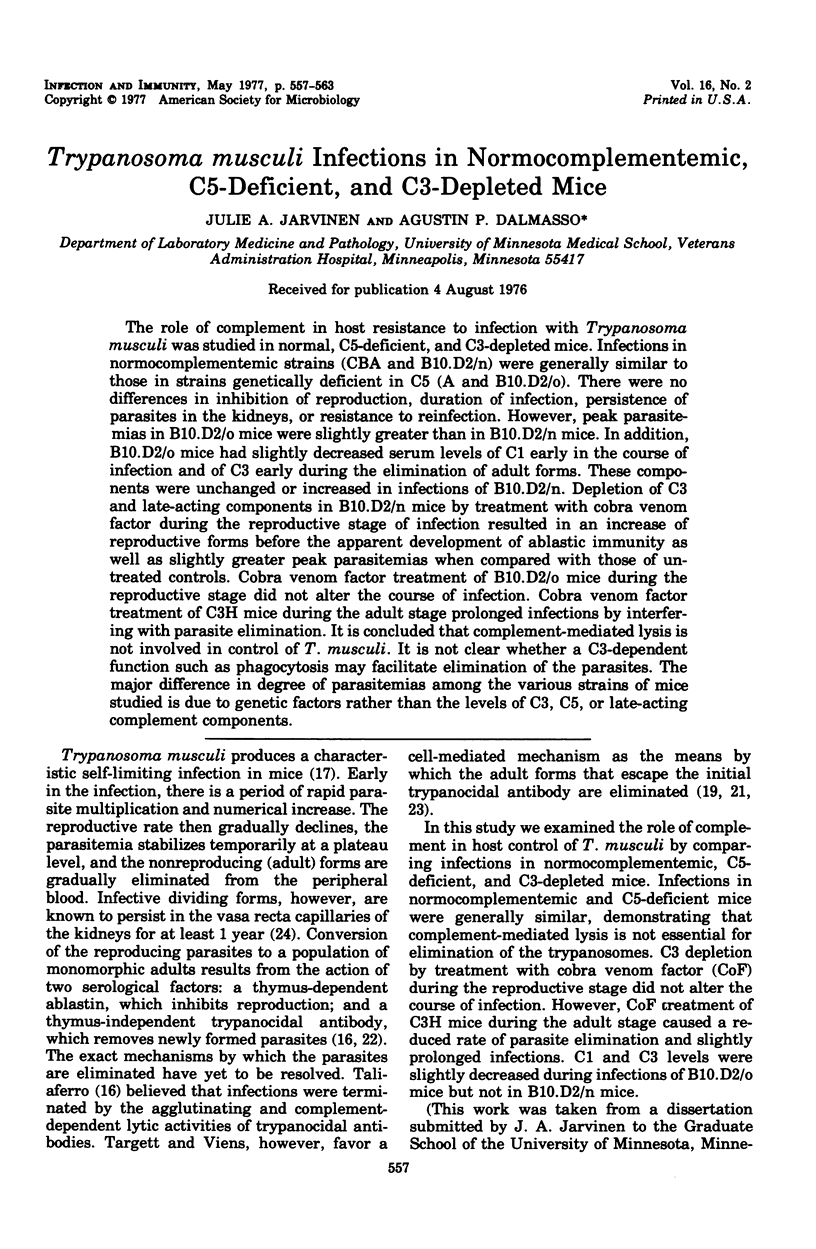
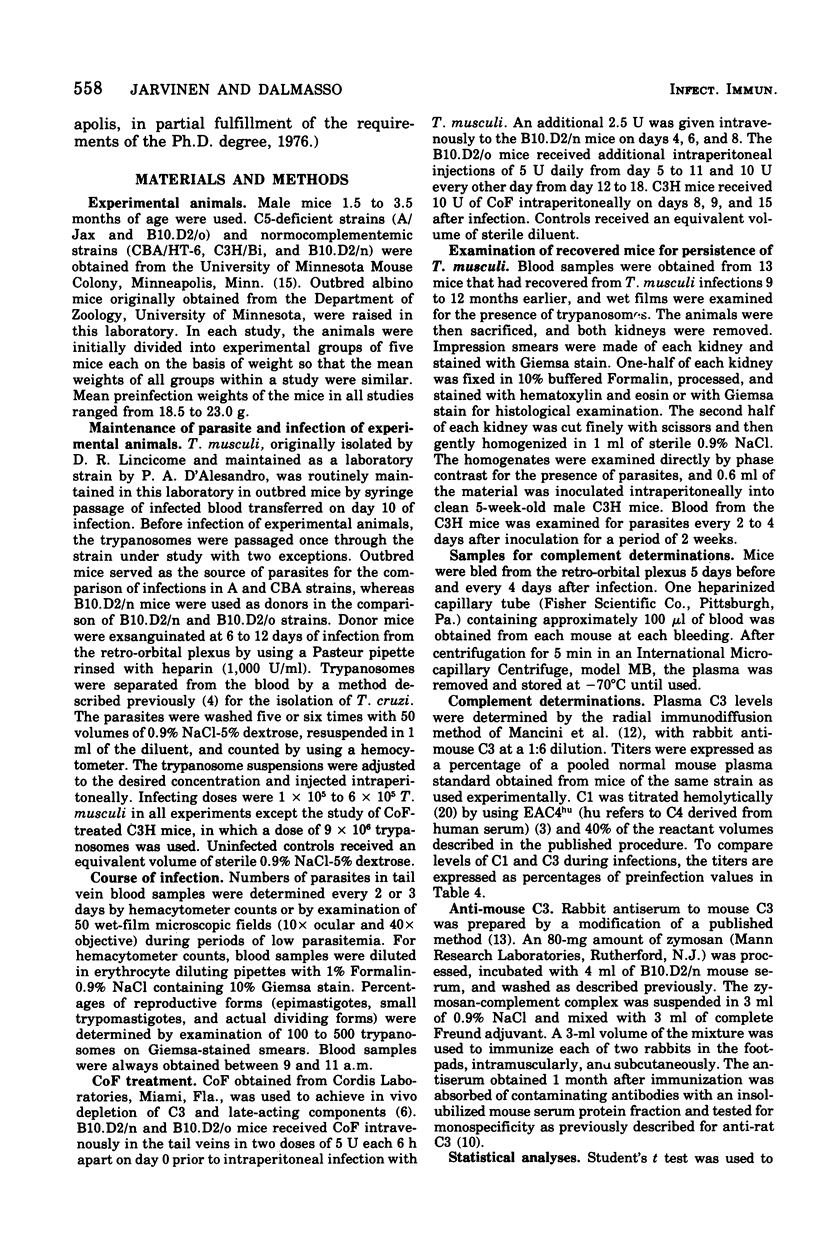
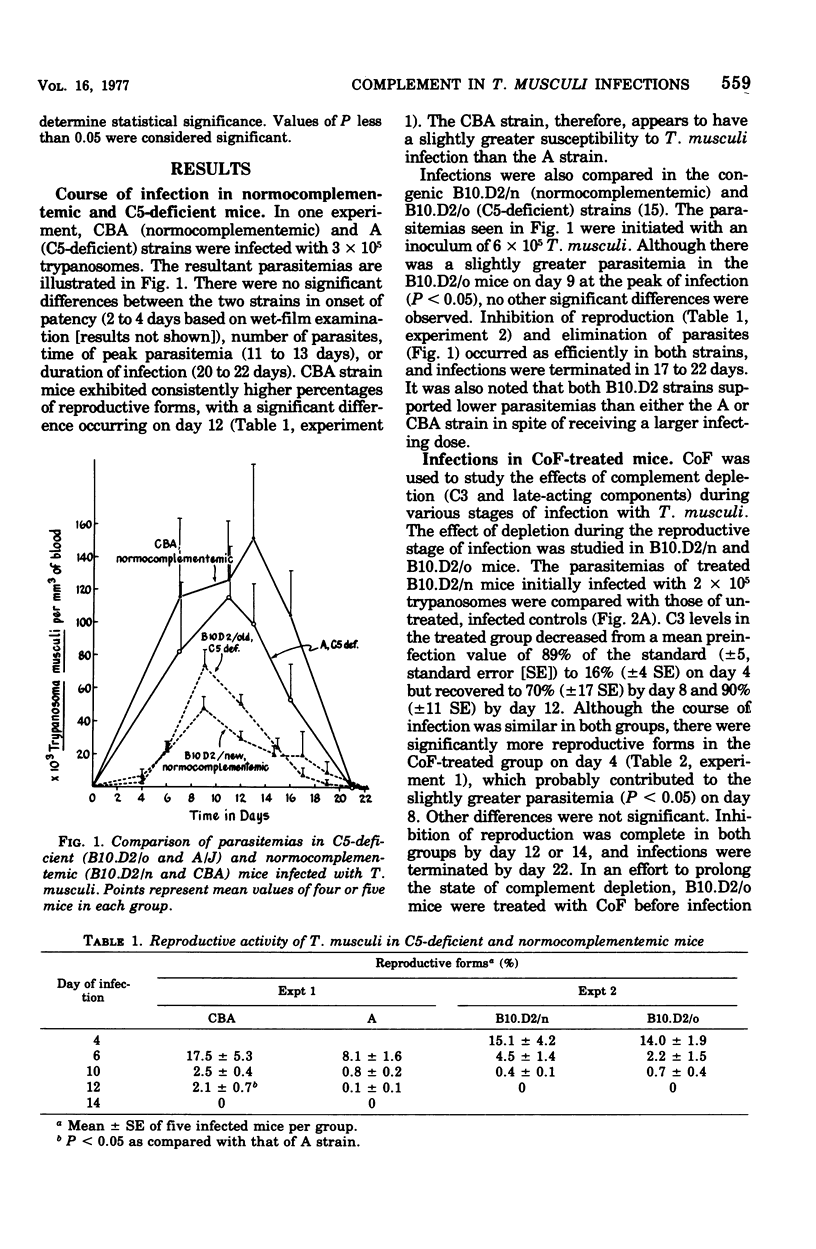
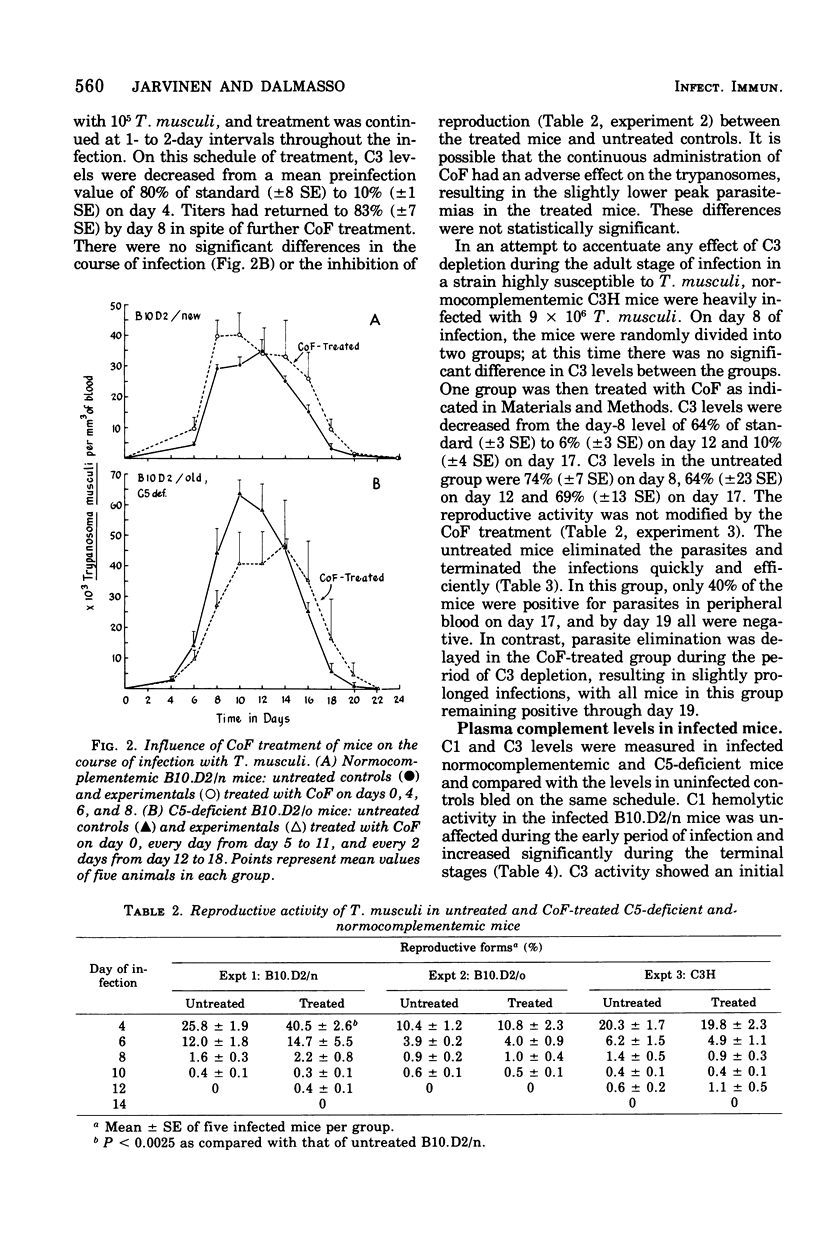
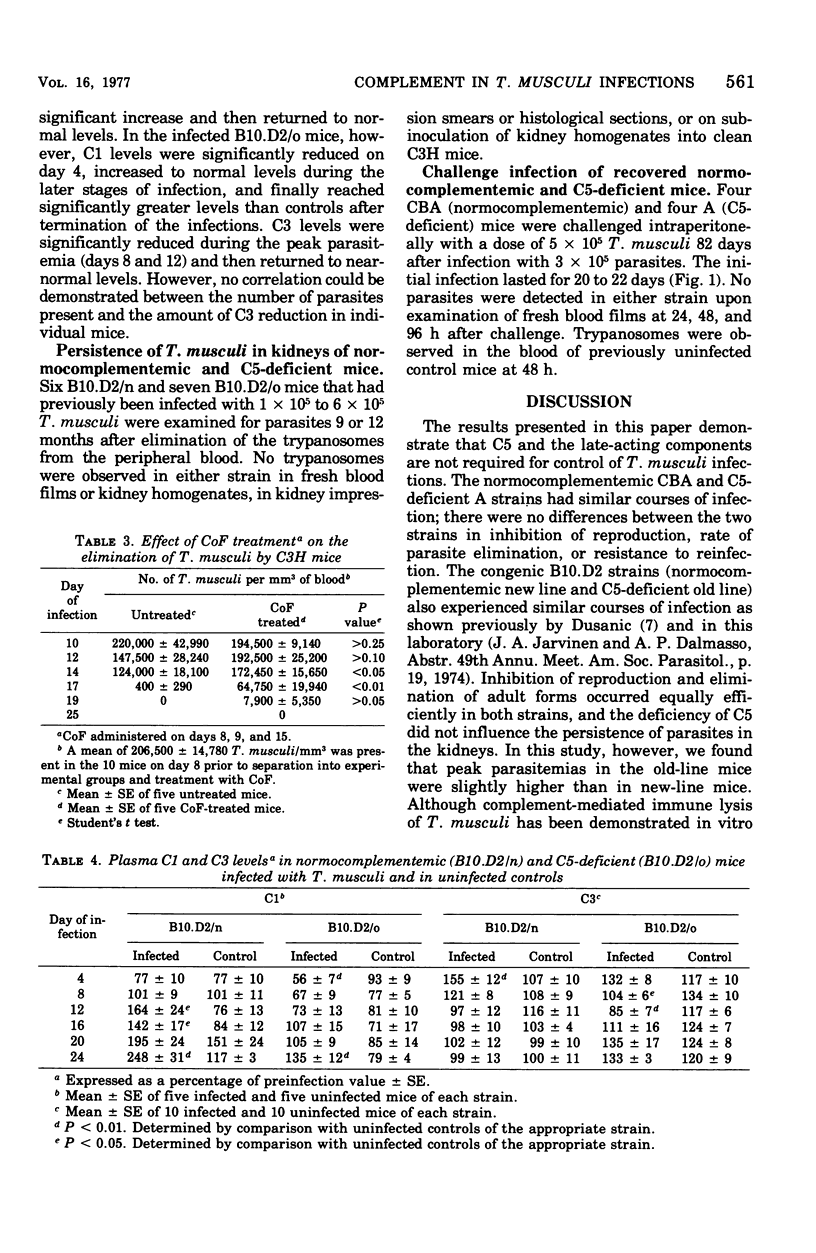
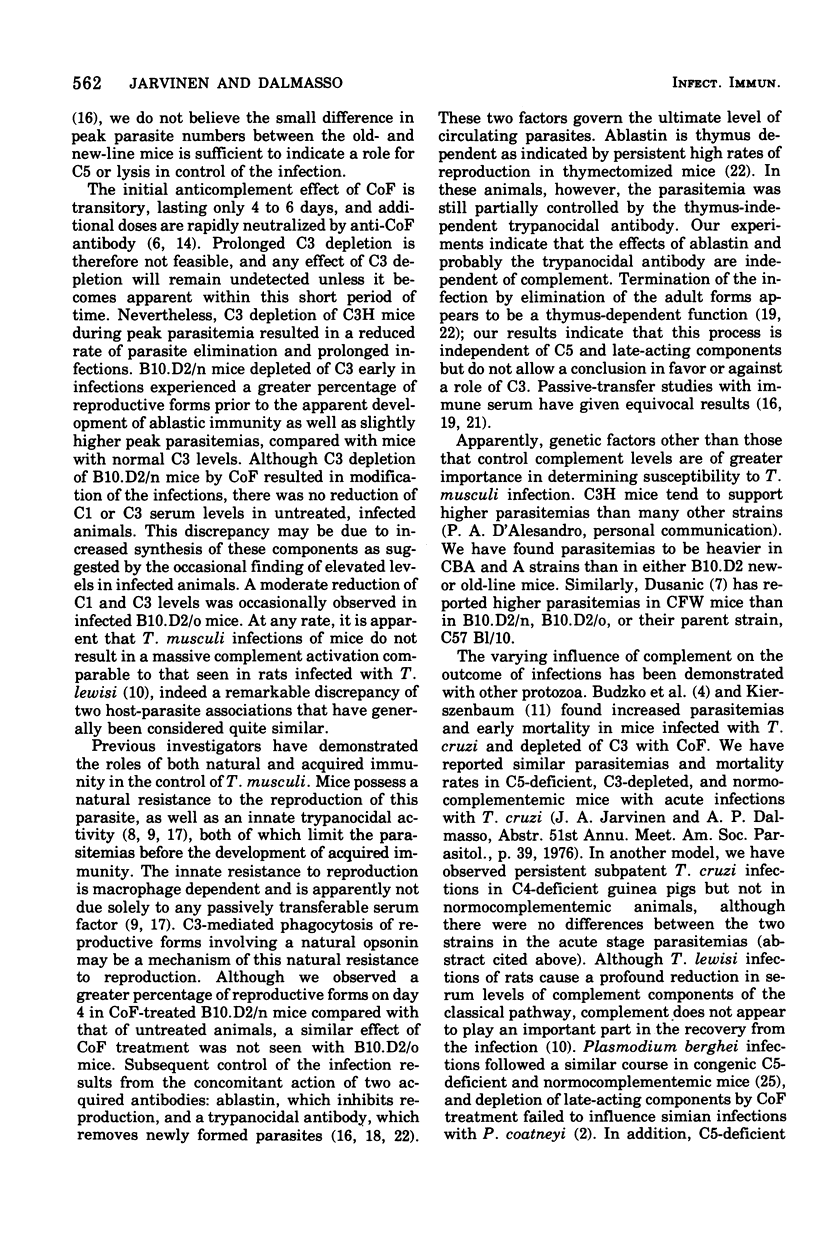
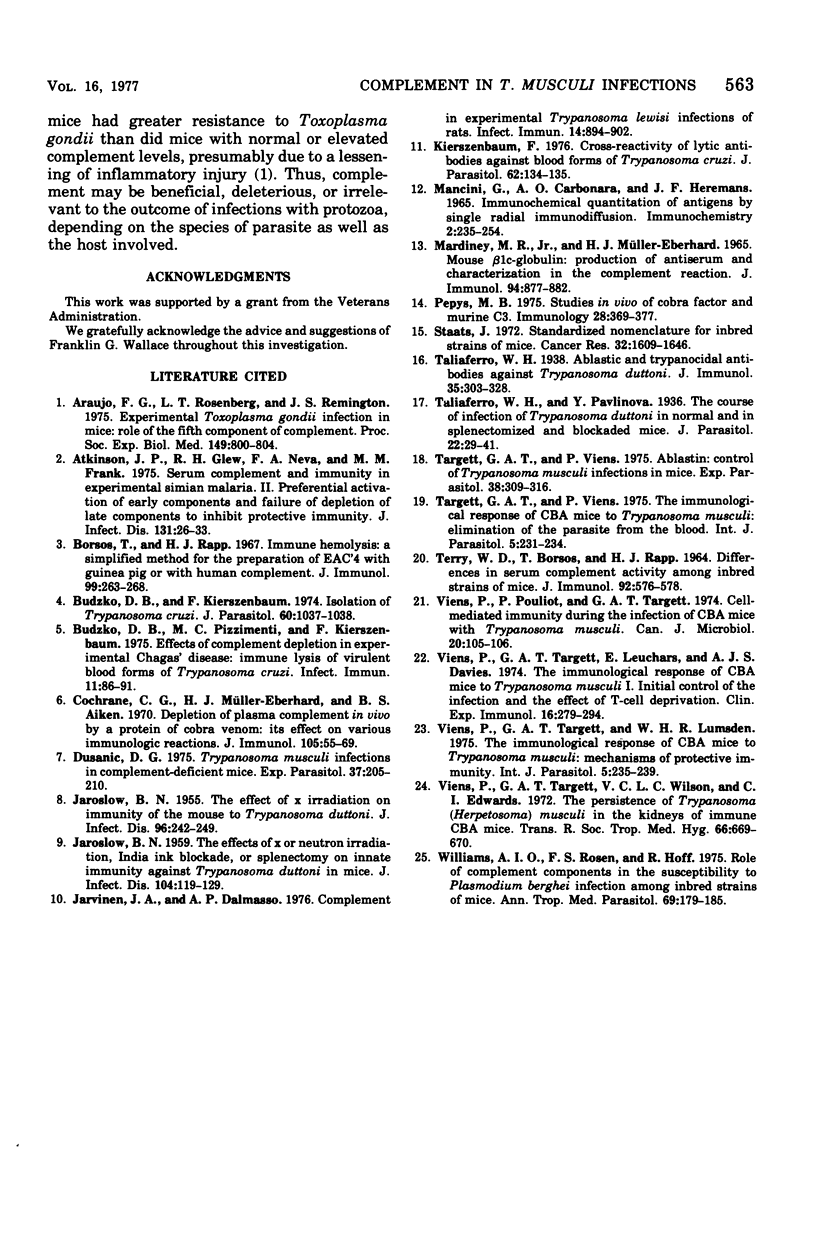
Selected References
These references are in PubMed. This may not be the complete list of references from this article.
- Araujo F. G., Rosenberg L. T., Remington J. S. Experimental Toxoplasma gondii infection in mice: the role of the fifth component of complement. Proc Soc Exp Biol Med. 1975 Jul;149(3):800–804. doi: 10.3181/00379727-149-38902. [DOI] [PubMed] [Google Scholar]
- Atkinson J. P., Glew R. H., Neva F. A., Frank M. M. Serum complement and immunity in experimental simian malaria. II. Preferential activation of early components and failure of depletion of late components to inhibit protective immunity. J Infect Dis. 1975 Jan;131(1):26–33. doi: 10.1093/infdis/131.1.26. [DOI] [PubMed] [Google Scholar]
- Borsos T., Rapp H. J. Immune hemolysis: a simplified method for the preparation of EAC'4 with guinea pig or with human complement. J Immunol. 1967 Aug;99(2):263–268. [PubMed] [Google Scholar]
- Budzko D. B., Kierszenbaum F. Isolation of Trypanosoma cruzi from blood. J Parasitol. 1974 Dec;60(6):1037–1038. [PubMed] [Google Scholar]
- Budzko D. B., Pizzimenti M. C., Kierszenbaum F. Effects of complement depletion in experimental chagas disease: immune lysis of virulent blood forms of Trypanosoma cruzi. Infect Immun. 1975 Jan;11(1):86–91. doi: 10.1128/iai.11.1.86-91.1975. [DOI] [PMC free article] [PubMed] [Google Scholar]
- Cochrane C. G., Müller-Eberhard H. J., Aikin B. S. Depletion of plasma complement in vivo by a protein of cobra venom: its effect on various immunologic reactions. J Immunol. 1970 Jul;105(1):55–69. [PubMed] [Google Scholar]
- Dusanic D. G. Trypanosoma musculi infections in complement-deficient mice. Exp Parasitol. 1975 Apr;37(2):205–210. doi: 10.1016/0014-4894(75)90071-5. [DOI] [PubMed] [Google Scholar]
- JAROSLOW B. N. The effect of X irradiation on immunity of the mouse to Trypanosoma duttoni. J Infect Dis. 1955 May-Jun;96(3):242–249. doi: 10.1093/infdis/96.3.242. [DOI] [PubMed] [Google Scholar]
- JAROSLOW B. N. The effects of X or neutron irradiation, India ink blockade, or splenectomy on innate immunity against Trypanosoma duttoni in mice. J Infect Dis. 1959 Mar-Apr;104(2):119–129. doi: 10.1093/infdis/104.2.119. [DOI] [PubMed] [Google Scholar]
- Jarvinen J. A., Dalmasso A. P. Complement in experimental Trypanosoma lewisi infection of rats. Infect Immun. 1976 Oct;14(4):894–902. doi: 10.1128/iai.14.4.894-902.1976. [DOI] [PMC free article] [PubMed] [Google Scholar]
- Kierszenbaum F. Cross-reactivity of lytic antibodies against blood forms of Trypanosoma cruzi. J Parasitol. 1976 Feb;62(1):134–135. [PubMed] [Google Scholar]
- MARDINEY M. R., Jr, MUELLER-EBERHARD H. J. MOUSE BETA-1C-GLOBULIN: PRODUCTION OF ANTISERUM AND CHARACTERIZATION IN THE COMPLEMENT REACTION. J Immunol. 1965 Jun;94:877–882. [PubMed] [Google Scholar]
- Mancini G., Carbonara A. O., Heremans J. F. Immunochemical quantitation of antigens by single radial immunodiffusion. Immunochemistry. 1965 Sep;2(3):235–254. doi: 10.1016/0019-2791(65)90004-2. [DOI] [PubMed] [Google Scholar]
- Pepys M. B. Studies in vivo of cobra factor and murine C3. Immunology. 1975 Feb;28(2):369–377. [PMC free article] [PubMed] [Google Scholar]
- Staats J. Standardized nomenclature for inbred strains of mice: fifth listing. Cancer Res. 1972 Aug;32(8):1609–1646. [PubMed] [Google Scholar]
- TERRY W. D., BORSOS T., RAPP H. J. DIFFERENCES IN SERUM COMPLEMENT ACTIVITY AMONG INBRED STRAINS OF MICE. J Immunol. 1964 Apr;92:576–578. [PubMed] [Google Scholar]
- Targett G. A., Viens P. Ablastin: control of Trypanosoma musculi infections in mice. Exp Parasitol. 1975 Dec;38(3):309–316. doi: 10.1016/0014-4894(75)90116-2. [DOI] [PubMed] [Google Scholar]
- Targett G. A., Viens P. The immunological response of CBA mice to Trypanosoma musculi: elimination of the parasite from the blood. Int J Parasitol. 1975 Apr;5(2):231–234. doi: 10.1016/0020-7519(75)90034-x. [DOI] [PubMed] [Google Scholar]
- Viens P., Pouliot P., Targett G. A. Cell-mediated immunity during the infection of CBA mice with Trypanosoma musculi. Can J Microbiol. 1974 Jan;20(1):105–106. doi: 10.1139/m74-016. [DOI] [PubMed] [Google Scholar]
- Viens P., Targett G. A., Leuchars E., Davies A. J. The immunological response of CBA mice to Trypanosoma musculi. I. Initial control of the infection and the effect of T-cell deprivation. Clin Exp Immunol. 1974 Feb;16(2):279–294. [PMC free article] [PubMed] [Google Scholar]
- Viens P., Targett G. A., Lumsden W. H. The immunological response of CBA mice to Trypanosoma musculi: mechanisms of protective immunity. Int J Parasitol. 1975 Apr;5(2):235–239. doi: 10.1016/0020-7519(75)90112-5. [DOI] [PubMed] [Google Scholar]
- Viens P., Targett G. A., Wilson V. C., Edwards C. I. The persistance of Trypanosoma (Herpetosoma) musculi in the kidneys of immune CBA mice. Trans R Soc Trop Med Hyg. 1972;66(4):669–670. doi: 10.1016/0035-9203(72)90318-5. [DOI] [PubMed] [Google Scholar]
- Williams A. I., Rosen F. S., Hoff R. Role of complement components in the susceptibility to Plasmodium berghei infection among inbred strains of mice. Ann Trop Med Parasitol. 1975 Jun;69(2):179–185. doi: 10.1080/00034983.1975.11686999. [DOI] [PubMed] [Google Scholar]


